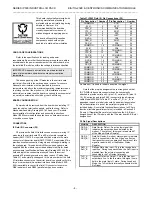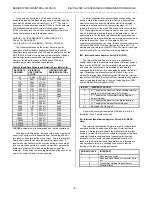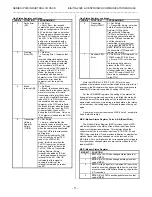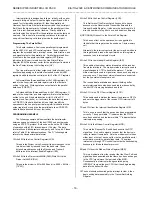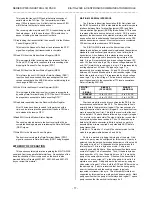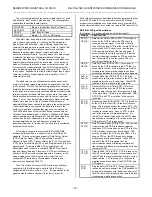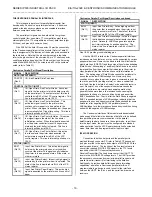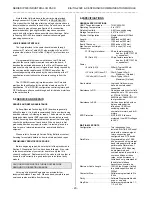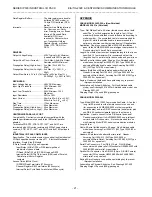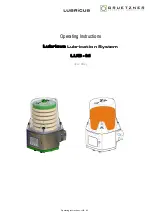
SERIES IP503 INDUSTRIAL I/O PACK EIA/TIA-232E & CENTRONICS COMMUNICATION MODULE
___________________________________________________________________________________________
- 6 -
IP503 Data, Status, and Control Registers
SERIAL DATA REGISTERS (Per Serial Port):
RBR
Receive Buffer Register
THR
Transmitter Holding Register
SERIAL STATUS REGISTERS (Per Serial Port):
LSR
Line Status Register
MSR
Modem Status Register
SERIAL CONTROL REGISTERS (Per Serial Port):
LCR
Line Control Register
FCR
FIFO Control Register
MCR
Modem Control Register
DLL
Divisor Latch LSB
DLM
Divisor Latch MSB
IER
Interrupt Enable Register
SCR
Scratch Pad/Interrupt Vector Register
CENTRONICS PORT REGISTERS:
LPT
Parallel Read/Write Data Register
LPS
Parallel Read Status Register
LPC
Parallel Read/Write Control Register
LEM
Line Printer Extended Mode Select (R/W)
LIM
Line Printer Interrupt Mode Select (R/W)
LIV
Line Printer Interrupt Vector Register (R/W)
The I/O space may be as large as 64, 16-bit words (128
bytes) using address lines A1A6,but the IP503 uses only a
portion of this space. The I/O space address map for the IP503
is shown in Table 31Note the base address for the IP module I/O
space (see your carrier board instructions) must be added to the
addresses shown to properly access the I/O space. All accesses
are performed on an 8-bit word basis (D0D7)
This manual is presented using the “Big Endian” byte
ordering format. Big Endian is the convention used in the
Motorola 68000 microprocessor family and is the VMEbus
convention. In Big Endian, the lower-order byte is stored at odd-
byte addresses. Thus, byte accesses are done on odd address
locations. The Intel x86 family of microprocessors use the
opposite convention, or “Little Endian” byte ordering. Little
Endian uses even-byte addresses to store the low-order byte. As
such, use of this module on an ISAbus (PC/AT) carrier board will
require the use of the even address locations to access the 8-bit
data, while a VMEbus carrier will require the use of odd address
locations
Note that some functions share the same register address.
For these items, the address lines are used along with the divisor
latch access bit (bit 7 of the Line Control Register) and/or the
read and write signals to determine the function required.
Beyond the first two address locations for each serial port, the
state of the divisor latch access bit is irrelevant
Table 31:IP503 R/W Space Address (Hex) Memory Map
Base
Addr+
MSB
D15D08
LSB
D07 D00
LC
R
Bit7
Base
Addr+
Serial Port A Registers:
00
Not Driven
1
READ - RBR
Port A Receiver
Buffer Register
0
01
00
Not Driven
1
WRITE - THR
Port A Transmitter
Holding Register
0
01
00
Not Driven
1
R/W - DLL
Port A Divisor
Latch LSB
1
01
02
Not Driven
1
R/W - IER
Port A Interrupt
Enable Register
0
03
02
Not Driven
1
R/W - DLM
Port A Divisor
Latch MSB
1
03
Base
Addr+
MSB
D15D08
LSB
D07 D00
Base
Addr+
04
Not Driven
1
READ - IIR
Port A Interrupt
Identification Register
05
04
Not Driven
1
WRITE - FCR
Port A FIFO Control
Register
05
06
Not Driven
1
R/W - LCR
Port A Line Control
Register
07
08
Not Driven
1
R/W - MCR
Port A Modem Control
Register
09
0A
Not Driven
1
R/W - LSR
Port A Line Status Register
0B
0C
Not Driven
1
R/W - MSR
Port A Modem Status
Register
0D
0E
Not Driven
1
R/W - SCR
Port A Scratch
Pad/Interrupt Vector
Register
0F
Serial Port B Registers:
Base
Addr+
MSB
D15D08
LSB
D07 D00
LC
R
Bit7
Base
Addr+
10
Not Driven
1
READ - RBR
Port B Receiver
Buffer Register
0
11
10
Not Driven
1
WRITE - THR
Port B Transmitter
Holding Register
0
11
10
Not Driven
1
R/W - DLL
Port B Divisor
Latch LSB
1
11
12
Not Driven
1
R/W - IER
Port B Interrupt
Enable Register
0
13
12
Not Driven
1
R/W - DLM
Port B Divisor
Latch MSB
1
13




